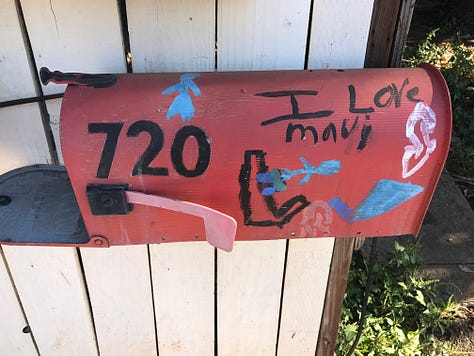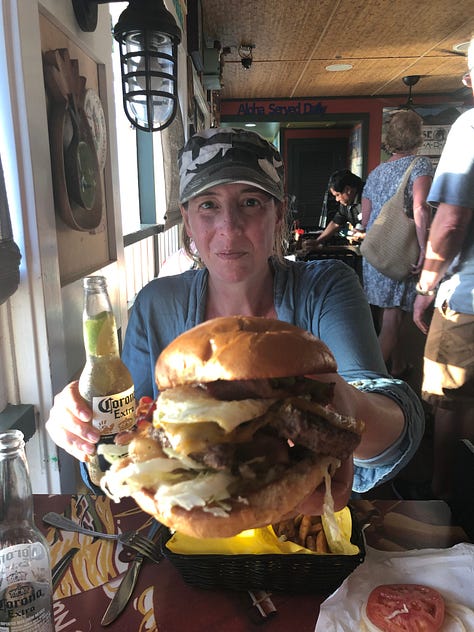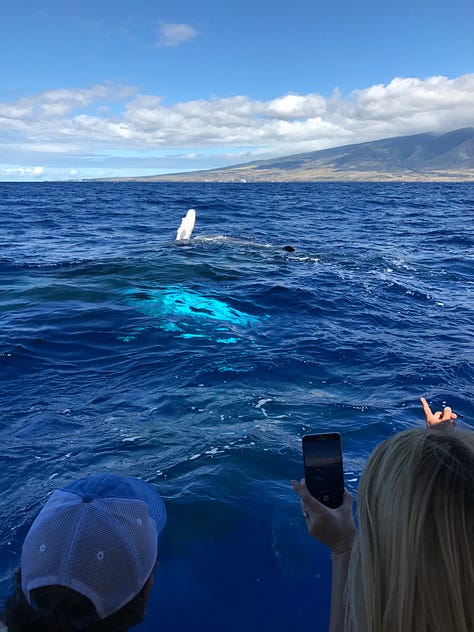Lahaina, heartbreak, and mounting costs
A personal note this week: I've found so much peace in Hawaii over the last decade. Watching Lahaina burn is a cold reminder of the losses that will continue to pile up.
I started this newsletter last week, when we were just starting to get a sense of how much devastation there really was in Maui (and some close-to-home scary events delayed things further—everyone is ok, which is all that needs reporting here).
It seems borderline self-indulgent now that we know the death toll is nearly 100, and may be that or more by the time you read this. But Maui and Lahaina harbor specifically are places deeply close to my heart, and I know I’m not alone in grieving their loss, and so I’m going to indulge—but only after donating to the Maui Strong Fund and whispering another prayer for those who have been lost.
For many years, until the pandemic, I made winter and early spring pilgrimages to Maui to watch the whales. I’d go with my friend Allison and we were hilariously hardcore. We’d pack in an absolutely absurd amount of whale-watching, day after day. I think the most we ever did was three trips in a day: a 6 am kayak tour, a midday Zodiac ride, a bonine-induced power nap in our open-top Jeep in the parking lot of a diner, and then another afternoon boat tour.
One year we got a screaming deal on the Ritz-Carlton and you could see the utter bemusement on the faces of the hotel staff and fellow guests as we’d tromp out first thing in the morning with backpacks and hats and water bottles and sunscreen, ignoring the breakfast buffet and resort amenities, and then arrive back in time for sunset bedraggled and salt-stained and sunburned and marveling, ignoring the restaurant and the resort luau in favor of dinner somewhere, anywhere, and bed, to get up and do it all over again. We had no chill. We were there to Watch. The. Whales.









The whales come because the waters around Maui are basically a big bathtub, as it was often explained to us. There’s a ring of underwater islands that create a big, warm, safe, protected body of water where, every winter and spring, humpback whales gather to play and fight and make and have babies. Words can’t even express how magical it is to see and experience. If you even glance at the horizon between say, January and May, you can’t not see some sort of whale activity. We’d see tangles of whales as big males made competition pods and slapped their fins and tried to ram each other below the surface, while females egged them on with fin and tail slaps of their own.
Once, a big male positioned himself directly under our boat while a female stationed herself nearby and appeared to treat her new baby to some reverse tourism. The baby rolled over the top of mom’s head, frolicked around the back of the boat, and spy-hopped up and down to peek at the people staring delightedly back at it. Hawaii state law says that if a whale is within a certain distance of your vessel during these breeding seasons, you’re not allowed to move, for fear of causing injury. So on the occasions when whales decide you’re the attraction, you’re stuck there until they get bored. Obviously, that’s the outcome you’re all hoping for.
These adventures are some of the most vivid memories and treasured adventures of my entire life. We experienced moments of true magic, wonders of nature, and I was moved to tears more than once—I was overwhelmed by gratitude and respect and awe at the beauty and the privilege of getting to experience such a place.
And almost all of these trips left from Lahaina Harbor.
That harbor, as we now all know, in addition to the surrounding downtown and swaths of Maui, are now gone—burned to the ground by terrifyingly fast-moving wildfires that have killed at least 96, as of this writing. The massive banyan tree that sits in the Lahaina square has reportedly been charred and I can only pray it survives. Boats burned right there in the harbor. The before and after videos are horrifying.
Did Lahaina burn because of global warming? Of course, at least partly—forecasters predicted a busier-than-usual hurricane season, and winds from Hurricane Dora whipped the fires through Lahaina Town so fast that people had to leap into the water to escape them. Drought made the area more flammable, noted CNN:
Drought conditions are becoming more extreme and common in Hawaii and other Pacific islands, according to the US National Climate Assessment released in 2018. Scientists noted in that report that the rainfall has generally been decreasing in Hawaii over time, with the number of consecutive dry days increasing.
And of course the picture is complicated by the fact that Maui is burning because of the climate damage humans have done and also what humans have brought to the islands, like highly flammable non-native grasses.
This is, as Alex Steffen put it in our interview last week on Everybody in the Pool, the future we have bought, with decades of climate inaction. And in fact, it’s not the future at all, he argues, and Lahaina proves quite conclusively. It’s the present.
These are the losses we must grow to expect, made worse with every capitulation to a fossil fuel economy. This one hits my heart, the next one may hit yours. The next one may hit you, in a place so completely unprepared for the coming disaster that there weren’t even functioning warning systems or water in the fire hydrants.
But make no mistake—there will be one. The losses will mount. I believe the wins will, too; I remain optimistic that we have the tools, the awareness, the momentum, and the urgency, and Steffen noted in our interview that assuming we remain on a path to net zero, it’s likely we can avoid the most catastrophic potential outcomes of a warming planet.
But this is, as he pointed out, the future we have bought. The confluence of El Nino and global warming makes it likely that the earth will overshoot 1.5 degrees Celsius in temperature rise sometime in 2024. That’s the target identified in the 2015 Paris agreement as the point after which a global tipping point could throw the world into climate chaos, and a cascade of unpredictable weather patterns, ice melt, sea level rise, crop failures, and other catastrophes.
From here out, nearly every disaster is likely to be a climate disaster, and they are likely to grow in number and severity. Take a moment to mourn and then please, do what you can.
Small wins:
I don’t want to leave on such a sad note, and I do want to celebrate what is actually a huge win: the brave young people in Montana who won their lawsuit against the state for violating their right to a “clean and healthful environment.” Montana is my home state, so this feels especially profound. It is the fourth-largest coal-producing state in the country and home to the biggest reserve of recoverable coal in the US. But the state constitution guarantees that clean and healthful environment, and of course they wrote that in, because Montana is nothing if not a spectacular display of natural beauty itself. The ruling requires the state to do more to protect its residents from climate change. The law firm representing the 16 young plaintiffs has filed similar lawsuits in all 50 states. (And yes, I’ve invited them on the podcast!)
Required reading:
As I’ve thought all week about the loss of Lahaina Harbor, I’ve also been thinking constantly about this book, All We Can Save, a beautiful compilation of essays and poems and art, curated by Dr. Ayana Johnson and Katharine Wilkinson, that is full of ideas and hope and emotion and coping skills and love for what we have, have had, and can still have. It’s a good place to put some of the grief and anxiety that might be welling up this week (or any week).
Thank you for your patience, readers, with my self-indulgence and my spotty track record of late. We’re back on track, I’m grateful for all of you who are reading and listening and most of all, trying.
See you next week.


Thank you for sharing your memories. What an amazing thing to do! The whales are still there, at least at the moment. You’ll see them again.
Beautiful Molly…